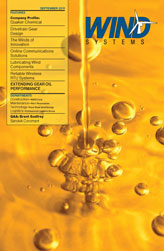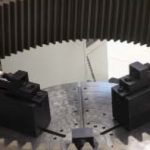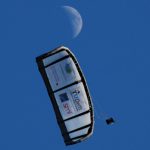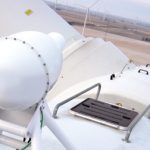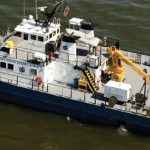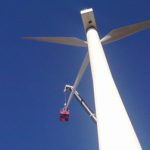Equipment lubrication is the lifeblood of any electrical system, from the large-scale wind farm to the small single-pole 20-amp circuit breaker in our homes. Whether the lubrication is in the form of grease, oil, or powder the proper selection and application is huge, and the consequences of not correctly applying and maintaining lubrication through the life of the electrical system can be disastrous.
Considering all of the related training seminars, certifications, application tools, manufacturers’ published data, and the overall industry awareness about the importance of lubrication, the failure of rotating machines should be rare and unheard of. But the truth is that lubrication-related failures happen every day, and with a high cost to production, reliability, and worst of all to safety. This article will explain some of the common terms and best practices that an owner/operator of a wind farm can use to keep his or her equipment properly lubricated so they don’t get burned by failures and downtime.
Learning the Lingo
Understanding “lubrication lingo” is important when dealing with electrical equipment. Think about the physical properties of lubrication with these terms and how they can apply to electrically driven mechanical devices.
Lubrication: The process or technique employed to reduce wear of one or all surfaces in close proximity and moving relative to each another by interposing a substance called lubricant between the surfaces to carry or to help carry the load (pressure generated) between the opposing surfaces.
Elastohydrodynamic lubrication: Opposing surfaces are separated by just a few microns of lubrication, but there is interaction between the raised solid features called asperities, and there is an elastic deformation on the contacting surface, enlarging the load-bearing area whereby the viscous resistance of the lubricant becomes capable of supporting the load.
Boundary lubrication (also called boundary film lubrication): The bodies come into closer contact at their asperities; the heat developed by the local pressures causes a condition which is called stick-slip, and some asperities break off. At the elevated temperature and pressure conditions, chemically reactive portions of the lubricant react with the contact surface forming a resistant layer or film on the moving solid surfaces (boundary film) which is capable of supporting the load and major wear or breakdown is avoided.
Oil viscosity: Viscosity is the capacity of a fluid to provide resistance, and thus friction, to an opposite laminar movement of two adjacent layers. If you have high viscosity there is a high resistance to flow, whereas a low viscosity is a thin fluid. Viscosity should be appropriate for the load and speed of the application at operating temperature. This will help to insure maximum protection and component life.
Grease consistency: The consistency of grease is one of its most visible characteristics, and the consistency of grease should be appropriate to the application as it affects the ability to reach the areas to be lubricated. An NLGI (National Association of Lubricating Grease Manufacturers) grade 2 grease is the most commonly used grease in electric motor and generator applications.
Oxidization resistance: Oxidation resistance is a behavior of lubricant greases that are exposed under static (in-service) conditions and influenced by the atmosphere for a prolonged period of time. Electric motor greases should have outstanding resistance to oxidation, as this extends the life of bearings running at high speeds and high temperatures, such as greases with a high ASTM D 3336 oxidation life.
Anti-wear and extreme pressure additives: Anti-wear or AW additives are for lubricants that help prevent metal-to-metal contact between parts of gears and bushings and usually contain zinc or phosphorous compounds. Extreme pressure (EP) additives are commonly used in applications such as gearboxes or where there is a thrust load on bearings. AW additives are used with lighter loads such as hydraulic and automotive engines. EP additives can shorten the life of the grease and should not be used where they are not needed.
Dropping point: The dropping point of lubricating grease is the temperature at which it passes from a semi-solid to a liquid state. It is used in combination with other testable properties to determine the suitability of greases for specific applications. It is applicable only to grease that contains soap thickeners made of fatty acids or metallic salts.
So what does it all mean? In layman’s terms, “lubrication” really means reducing the surface friction between two components with oil or grease that creates a small amount of pressure to keep the two components equally apart. Lubricants also act as a coolant to contact areas and can assist in the removal of wear products. While carrying out these functions the lubricant is constantly replaced from the contact areas either by the relative movement (hydrodynamics) or by externally induced forces. Without lubrication you will likely have equipment seizures that are similar to the welding together of components… or even get burned, literally and physically!
Keeping it Lubed
The average gearbox takes a lot of abuse, and when applied to wind it is actually an extreme engineering challenge due to the difficulty in properly assessing the loads—in particular the non-torsional loads that pass through the gearbox—and how these affect bearings and gears. A gearbox absorbs additional loads introduced by the rotor such as shaft bending through a single bearing assembly and deflections of the bedplate and main bearing, not to mention alignment issues. This makes for a nasty mess that could propagate additional points of failure due to lubrication contamination. These contaminants create issues like micro-pitting, which can lead to wearing and changes in gear teeth shape and reducing gear accuracy, increasing vibrations, noise, and eventual misalignment and failure. Most gearbox manufacturers utilize a special gearbox oil filter, which helps ensure maximum oil cleanliness. This is a key factor in environments where dust and debris can get into gearboxes and eventually lead to contact fatigue failures.
Many motor and generator bearings are lubricated with an automatic greasing system. These auto lubrication systems promote improved operating times and longer maintenance intervals, typically one year or longer. Additional benefits are lower costs for repairs, spare parts, and lubricant, and greater bearing life from regular, exact amounts of lubrication. This system minimizes or eliminates safety risks associated with hard to reach lubrication points, increases corrosion protection from the elements, and significantly reduces the amount of wasted lubrication.
Lubrication issues on a circuit breaker can cause catastrophic results. The overall safety of the electrical worker has become a higher priority at the wind farm, and we cannot forget about what the lack of lubricant, and hardened lubrication, can do to an overcurrent protective device such as a circuit breaker. In 2007 The International Electrical Testing Association (NETA) performed a study of overcurrent protective devices tested on a normal and routine basis. This data was supplied by its member companies and analyzed a cross section of electrical equipment in North America. The survey yielded data about the average condition of electrical equipment currently in service throughout the United States. Of the defective devices found in the survey, 51.4 percent had lubrication issues with the breaker mechanism or operator.
Circuit breakers create a huge lubrication challenge since most of them remain static in the closed position and do not operate for months or even years at a time. When these protective devices are called on to operate and interrupt faults they may be slow, sluggish, or may not operate at all due to the factory lubrication drying out and/or hardening over time. This creates a coordination nightmare, and it increases arc duration and incident energy exposure. This situation can render the best electrical safety program, training, and PPE less effective, it can affect the results of the arc flash study, and worst of all it can lead to an electrical worker getting burned.
Getting Burned
It can be said that many of the lubrication issues that face the wind industry are very similar to those that exist in general industry. As a third party insulating oil and lubricant testing laboratory, many lubrication pitfalls are noted while analyzing wind generator oil and grease samples.
Lubrication quantity: An insufficient amount of grease and oil will lead to excessive wear and overheating, eventually leading to catastrophic failure. Excessive amounts of grease allow the rollers to slide in the journal, causing heating and scoring. Conversely, large amounts of grease can migrate into the generator windings creating potential contamination and electrical insulation issues.
Lubrication storage: Humidity, moisture, sand, and other contaminants are typically found in many samples. A drum of oil stored in the sun and allowed to cool during the night can collect as much as a gallon of water within a few weeks of being stored in such conditions. These same conditions will occur within lubricated systems like hydraulic reservoirs and gear cases. In these conditions, water-absorbing filtration systems should be considered.
Lubricant corrosion: Red/brown areas on balls, raceways, cages, or bands of ball bearings are symptoms of corrosion. This condition results from exposing bearings to corrosive fluids or a corrosive atmosphere. In extreme cases, corrosion can initiate early fatigue failures.
Lubrication sampling/trending: Contamination of lubricants by dirt, wear metals, water, or other particulate matter cause over 70 percent of lubrication related equipment failures.
Lubricant incompatibility: Incompatibility can be caused by something as simple as mixing two different greases or oils to the same lubricated component. Incompatible greases may be indicated when the oil in the grease begins to leak past the bearing seal within minutes of regreasing a bearing. Incompatible gear oils may cause oil seals to soften, shrink, or harden, resulting in a leak. Excessive foaming in a hydraulic reservoir may be the result of mixing two incompatible hydraulic oils.
Lubricant color: As oils age in service, it is normal for them to thicken and become darker in color. If an industrial oil becomes thicker and turns brown or almost black in color in an abnormally short period of time, however, the cause is almost always temperature related. Excessive operating temperatures will cause the oil to oxidize prematurely causing the viscosity to increase and the color to darken. Greases can also oxidize if a bearing is continually over greased.
Lubricant failure: Discolored (blue/brown) ball tracks and balls are symptoms of lubricant failure. Excessive wear of balls, rings, and cages will follow, resulting in overheating and subsequent catastrophic failure. Ball bearings depend on the continuous presence of a very thin (millionths of an inch) film of lubricant between balls and races and between the cage, bearing rings, and balls. Failures are typically caused by restricted lubricant flow or excessive temperatures that degrade the lubricant’s properties.
Lubricant contamination: Many of the gearbox and generator manufacturers utilize epoxies and specialty glues to attach bearing covers, inspection ports, and filler caps. Many times trace to large amounts of these substances are found in grease and oil samples, or worse implicated in bearing failures of gearboxes and generators. The largest majority of sample data has shown that high ferrous and ferrous particles are usually present. Large amounts of sand and epoxies contribute to excessive wear, overloading, and overheating that eventually leading to catastrophic bearing failure.
To-Do List
To maintain reliable systems, during the uptower inspection process you should have or develop an inspection, testing, and sampling route for the gearbox main shaft bearings and yaw/pitch gears. Typical time frames for the inspection process are:
• Monthly—visual inspection of the machines anchorage, alignment, oil levels, filters, pumps, valves, coolers, heaters, manifolds, and piping to connect components, as well as vibration sampling and analysis on the rolling elements.
• Quarterly—monitor the condition of the lubricating fluids through sampling and testing to determine wear and contamination levels for metals, viscosity, particle count, water/moisture, total acid number and oxidization/nitration through sampling and trending of gearbox oils and generator greases. If contamination is an ongoing issue, routine weekly sample cycles can help predict failure allowing for a pre-planned outage window for component repair/replacement.
• Every four to six months—perform lubricating oil filter changes, apply grease to gear teeth and slew bearings. Check and top off oil lubricants in yaw/pitch gears.
• Annually—inspect contact and wear patterns of gears and bearings on the rolling element with the use of borescope/videoscope cameras.
When maintaining collector substation and circuit breakers, develop electrical maintenance programs that employ a lubrication component as part of the program. You should develop the program based on national consensus standards (see references). Adopting a complete maintenance and lubrication plan will significantly reduce the risk of catastrophic equipment failure. With the high growth rate of wind power, understanding the impact of proper lubrication on high stress equipment is essential to achieve a high availability. Lubricating materials, procedures, and test methods are continually improving, providing invaluable tools for maintenance personnel that improve the operation and safety of wind power generators. So keep it lubed, and it will keep you from getting burned.
Conclusion
In spite of the high lightning risk that wind power system installations are exposed to, they can be protected by the application of Surge Protection Devices and Lightning Protection Systems. Regarding SPDs, one must give thoughtful and careful consideration to the placement of the SPD on the system and what they are intended to protect, the connection from the system to the SPDs, and the proper bonding of all grounded members and the ground system. Also check for the adequate discharge rating of the SPD, the voltage protection level the SPD provides, the suitability of the SPD for the system it is applied to, and consideration to failure mode of SPDs and status indication. Also be mindful of local and remote status indication and easily replaceable modules, and the suitability of SPDs on systems so as not to affect normal system function, specifically on non-power systems.
References:
1) IEEE STD 902-1998 (Yellow Book) Guide for Maintenance, Operation and Safety of Industrial and Commercial Power Systems.
2) NFPA 70B, Recommended Practice for Electrical Equipment Maintenance.
3) International Electrical Testing Association (NETA) ANSI/NETA MTS-2011 Standard for Maintenance 1) Testing Specifications for Electrical Power Distribution Equipment and Systems.



















